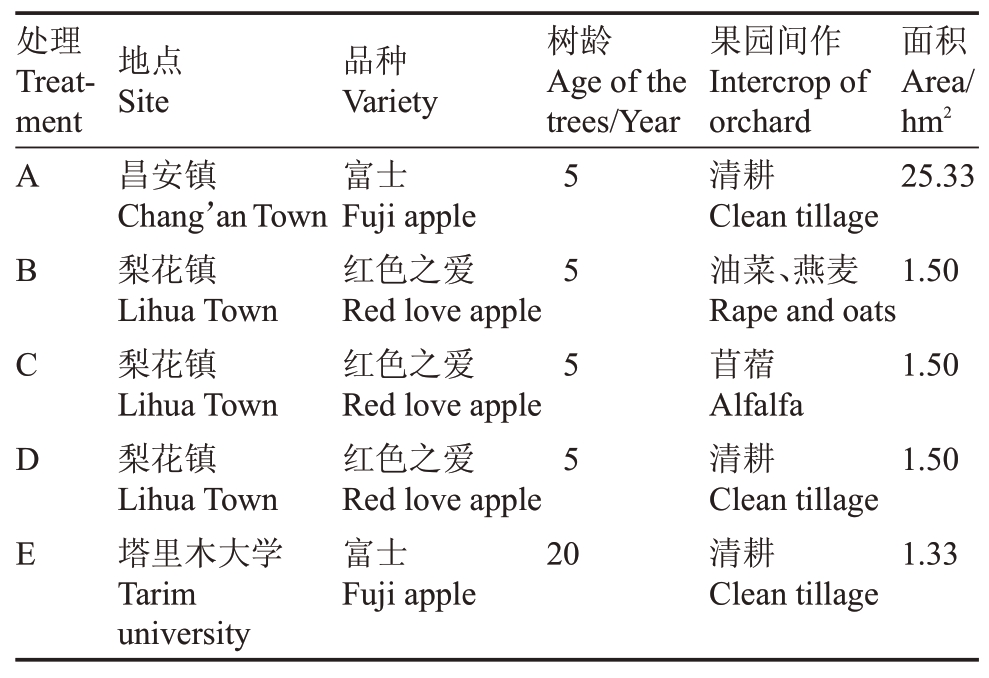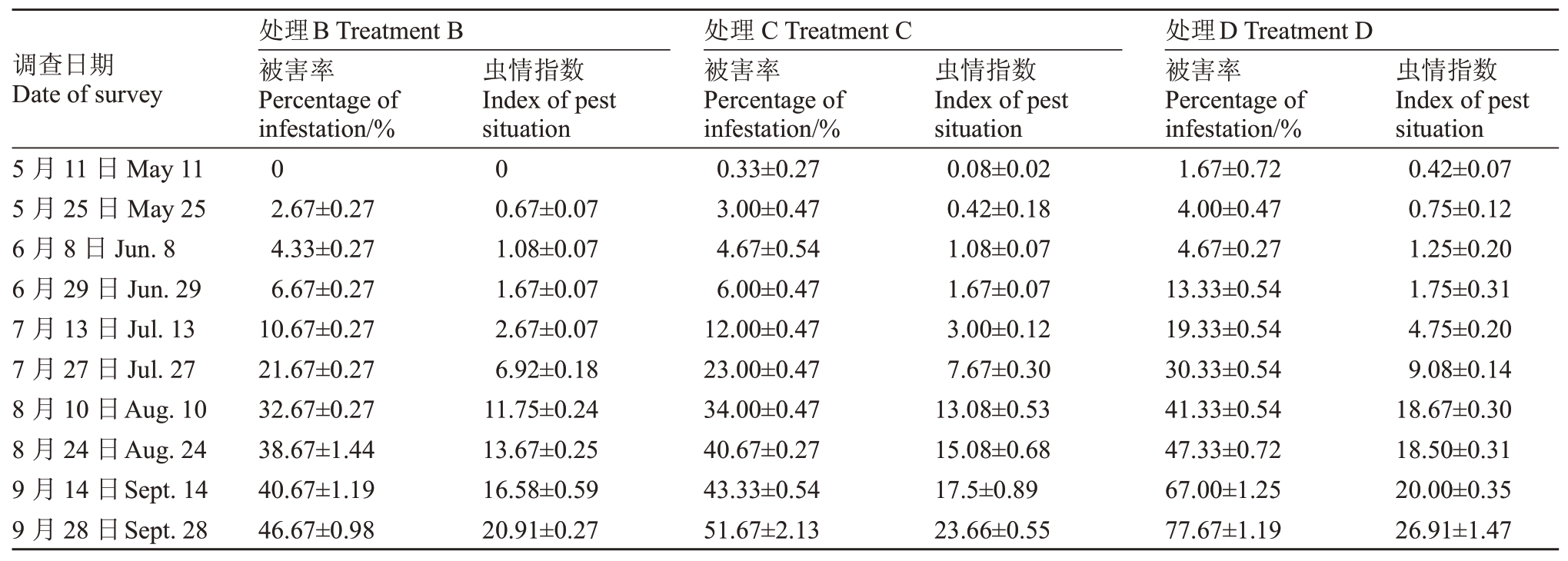金纹细蛾(Lithocolletis ringoniella Matsumura),属鳞翅目细蛾科,别名苹果细蛾、潜叶蛾,是一种果树潜叶性害虫,主要危害苹果,其次危害梨、桃、樱桃、海棠等果树[1-2]。以幼虫潜入叶片上下之间取食叶肉,致使下表皮与叶肉分离、皱缩、上表皮拱起;当成虫羽化时,蛹壳残留在下表皮上。发生严重的果园单叶虫斑可达十余个,导致叶面光合作用能力丧失,叶片提前脱落,果实生长受阻或者脱落,严重影响当年果实产量和次年结果[3]。该虫主要分布于日本、朝鲜及中国的辽宁、山东、河北、河南、山西、陕西、甘肃、安徽、江苏等苹果产区[2-5]。随着新疆特色果树产业的发展,金纹细蛾随果树苗木的调运传入新疆,2013年在伊犁州特克斯县发生危害,苹果园受害率在虫口发生盛期可达55%[6];2022年新疆维吾尔自治区林草局和新疆生产建设兵团林草局将该虫列为“新疆森林、草原、湿地生态系统外来入侵昆虫”重点普查对象。苹果是阿克苏地区重要经济果树之一,种植面积逐年增长,栽培品种以红富士为主。红富士是金纹细蛾的高感品种,加上金纹细蛾随气候变暖、种植模式改变等因素危害日益严重,金纹细蛾对阿克苏地区苹果的产量和品质造成了巨大影响。
目前,国内外学者对金纹细蛾的研究主要集中于形态特征和综合防治技术等方面[7-10],发生规律的研究在不同地区也有开展,如李永清等[11]研究发现金纹细蛾在昭阳区1年发生6代,其中第4代虫口数量最多,温度和降水量是发生量的重要影响因素。闫淼等[12]的研究结果证明金纹细蛾在洛川苹果园1年发生5 代,5 月上旬至10 月下旬为成虫发生始末期。白欣可等[13]研究表明金纹细蛾在庆阳市发生4代或5代。以上研究结果说明不同地区金纹细蛾发生世代存在差异。此外,不同地区苹果品种、田间温湿度、自然天敌也存在较大差异,都是影响金纹细蛾发生的重要因素[8]。阿克苏位于塔里木盆地北缘,拥有特殊的地理位置、气候及物种多样性,金纹细蛾的发生规律势必与其他地区存在差异。目前阿克苏地区金纹细蛾发生规律相关研究未见报道,金纹细蛾的危害程度愈加严重,为了明确金纹细蛾在新疆南部地区的发生规律及影响其发生程度的因素,笔者以阿克苏地区境内的阿拉尔市为研究区域,选择了不同树龄、不同品种、不同生草方式的果园,利用性诱剂诱捕法和田间调查法开展研究,以期为南疆苹果产区金纹细蛾的综合治理提供科学依据。
1 材料和方法
1.1 试验材料与地点
金纹细蛾性诱芯和三角板型性诱剂诱捕器,购自北京中捷四方生物科技有限公司,每套诱捕器悬挂一枚诱芯并安装一块粘虫板。
试验点位于阿克苏地区境内的阿拉尔市9 团(40°33'13″ N,81°02'01″ E)、10 团(40°34'54″ N,81°18'42″ E)和塔里木大学(40°32'56″N,81°17'22″E)3个果园,设5个处理。采用统一管理模式,修剪、整形、施肥和浇水等田间管理措施保持一致,清耕区杂草进行间断性人工除草。各处理具体信息见表1。
表1 试验地概况
Table 1 Overview of the test site

处理Treatment树龄Age of the trees/Year ABCDE地点Site昌安镇Chang’an Town梨花镇Lihua Town梨花镇Lihua Town梨花镇Lihua Town塔里木大学Tarim university品种Variety富士Fuji apple红色之爱Red love apple红色之爱Red love apple红色之爱Red love apple富士Fuji apple 5555面积Area/hm2 25.33 1.50 1.50 1.50 20果园间作Intercrop of orchard清耕Clean tillage油菜、燕麦Rape and oats苜蓿Alfalfa清耕Clean tillage清耕Clean tillage 1.33
1.2 金纹细蛾成虫发生动态调查
在各处理果园分别放置3套金纹细蛾诱芯及配套诱捕器,用铁丝悬挂于果树阴面通风处的树干上,高度1.5 m 或树冠中下部。从3 月12 日起到9 月28日结束,每周调查1 次粘虫板上金纹细蛾的数量并更换粘虫板,诱芯每3周更换一次,换下的诱芯带回后统一销毁,调查持续到果树落叶期结束。
1.3 金纹细蛾危害程度调查
每个处理果园采用五点取样法随机选5株树进行标记,从5月20日起到9月28日结束,每月调查2次,在每株树的东、南、西、北、中5个方位各确定1个枝条,每个枝条上调查20枚叶,每株树共调查100枚叶,分级统计被害叶片数。分级标准如下:0 级,无虫伤痕;1 级,叶片有1 个虫斑;2 级,叶片有2 个虫斑;3 级,叶片有3 个虫斑;4 级,叶片有4 个以上虫斑。计算虫情指数和叶片被害率,公式如下:

1.4 数据统计与分析
采用Excel 2007 和DPS9.5 软件进行数据处理与分析及图表制作。气象数据由阿拉尔市气象观测站提供。
2 结果与分析
2.1 金纹细蛾成虫种群发生动态
阿拉尔市不同果园多点诱捕金纹细蛾成虫种群发生动态结果显示(图1),5个处理金纹细蛾成虫发生趋势基本一致,都有6次明显的动态波动周期,表明在阿拉尔地区金纹细蛾一年发生6 代,并以蛹在受害落叶中越冬。处理A金纹细蛾越冬代成虫3月中旬出现,并随气温升高数量明显增多,3月30日达到高峰期,其他处理于4月6日达到高峰,4月底5月初为越冬代成虫羽化末期。第一代成虫发生期为5月上旬至6 月上旬,第二代6 月中旬至7 月中旬,第三代7月中旬至8月上旬,第四代8月中旬至8月下旬,第五代9月上旬至10月。每个地点所诱到的成虫各世代之间无明显的间断期,表明金纹细蛾有世代重叠现象。从各代发生高峰期日期及数量可以看出,第一、二代数量较少,且持续时间长;第三、四代成虫的数量明显增多,持续时间缩短;第五代成虫持续时间延长,9月中旬之后其数量急剧下降,说明金纹细蛾的成虫数量和世代历期与气温有关。从第一代到第五代有逐渐增加的趋势,第六代老熟幼虫在危害叶片虫斑内化蛹越冬。

图1 金纹细蛾成虫种群消长动态
Fig.1 Dynamics of adult population of L.ringoniella
2.2 温度对金纹细蛾种群动态的影响
从图1 可以看出,3 月中旬连续7 d 平均气温稳定达到7.1 ℃时,越冬代开始羽化,随气温升高数量逐渐增多,7—8月连续7日平均气温在23~28 ℃,第三、四代也是成虫羽化最多的世代,金纹细蛾世代历期也随气温升高而缩短。金纹细蛾在变温条件下全世代发育起点气温是7.1 ℃,需要的有效积温为503.2 ℃·d[7]。按照这一气温指标统计了2019年阿拉尔春季气温,发现5 月11 日大于7.1 ℃的有效积温为501.0 ℃·d,5 月12 日为511.4 ℃·d,则第一代成虫出现日期为5 月11—12 日,与实际观测到的日期相符。2019年阿拉尔全年有效积温为2 904.9 ℃·d,计算结果金纹细蛾在阿拉尔1年可发生5.8代,与实际调查结果基本一致。
2.3 果园间作对金纹细蛾发生的影响
金纹细蛾成虫在不同间作类型果园中发生趋势基本一致,都有6个高峰期,但各代高峰期发生数量不同(图1)。金纹细蛾越冬代成虫高峰期为4 月6日,清耕果园、间作1年生绿肥作物和多年生绿肥作物的果园诱捕量分别为308、158.25 和142.75 头·板-1。第1~5代清耕果园成虫发生量明显高于间作绿肥果园。三种不同间作类型的果园5月11日出现被害状,并随时间的推移叶片被害率和虫情指数逐渐增高(表2)。通过虫情指数和叶片被害率判断三种类型果园受影响程度的顺序为:处理D>处理C>处理B。
表2 不同间作的苹果园金纹细蛾危害动态
Table 2 Damage dynamics of L.ringoniella in different intercropping apple orchards

调查日期Date of survey 5 月11 日May 11 5 月25 日May 25 6 月8 日Jun.8 6 月29 日Jun.29 7 月13 日Jul.13 7 月27 日Jul.27 8 月10 日Aug.10 8 月24 日Aug.24 9 月14 日Sept.14 9 月28 日Sept.28处理B Treatment B被害率Percentage of infestation/%0 2.67±0.27 4.33±0.27 6.67±0.27 10.67±0.27 21.67±0.27 32.67±0.27 38.67±1.44 40.67±1.19 46.67±0.98虫情指数Index of pest situation 0 0.67±0.07 1.08±0.07 1.67±0.07 2.67±0.07 6.92±0.18 11.75±0.24 13.67±0.25 16.58±0.59 20.91±0.27处理C Treatment C被害率Percentage of infestation/%0.33±0.27 3.00±0.47 4.67±0.54 6.00±0.47 12.00±0.47 23.00±0.47 34.00±0.47 40.67±0.27 43.33±0.54 51.67±2.13虫情指数Index of pest situation 0.08±0.02 0.42±0.18 1.08±0.07 1.67±0.07 3.00±0.12 7.67±0.30 13.08±0.53 15.08±0.68 17.5±0.89 23.66±0.55处理D Treatment D被害率Percentage of infestation/%1.67±0.72 4.00±0.47 4.67±0.27 13.33±0.54 19.33±0.54 30.33±0.54 41.33±0.54 47.33±0.72 67.00±1.25 77.67±1.19虫情指数Index of pest situation 0.42±0.07 0.75±0.12 1.25±0.20 1.75±0.31 4.75±0.20 9.08±0.14 18.67±0.30 18.50±0.31 20.00±0.35 26.91±1.47
2.4 品种对金纹细蛾发生的影响
由图1 可知,富士苹果(处理A)金纹细蛾越冬代发生期持续时间长(3月中旬至4月下旬),高峰期(3月30日)平均诱捕量为293头·板-1,红色之爱苹果(处理D)金纹细蛾越冬代发生期较为集中(4月上旬至4月下旬),高峰期(4月6日)较处理A发生期迟1周左右,高峰期诱捕量为315头·板-1。从图1可以看出,两果园金纹细蛾越冬代成虫数量相差不大,但其后的各代发生量处理D明显高于处理A。
从果树整个生长期看,金纹细蛾在富士、红色之爱两个苹果品种上的虫情指数和叶片被害率随时间的推移呈逐渐升高趋势(表3)。两品种5 月中旬出现为害状,处理D 和处理A 虫情指数和叶片被害率分别为0.42、0.17 和1.67%、0.67%;7 月后虫情指数和叶片被害率增长迅速,到8月10日,处理D和处理A 虫情指数和叶片被害率分别为18.67、6.42 和41.33%、15.00%,9月中下旬虫情指数和叶片被害率达到最高,分别为26.91、16.75 和77.67%、32.67%。结果表明,金纹细蛾对红色之爱的嗜好性明显强于富士。
表3 不同品种的苹果园金纹细蛾危害动态
Table 3 Damage dynamics of L.ringoniella in different varieties apple orchards

调查日期Date of survey 5 月11 日May 11 5 月25 日May 25 6 月8 日Jun.8 6 月29 日Jun.29 7 月13 日Jul.13 7 月27 日Jul.27 8 月10 日Aug.10 8 月24 日Aug.24 9 月14 日Sept.14 9 月28 日Sept.28处理A Treatment A被害率Percentage of infestation/%0.67±0.27 1.33±0.27 2.33±0.27 4.67±0.54 10.00±0.82 15.67±0.98 15.00±0.47 18.00±0.47 25.00±0.47 32.67±0.27虫情指数Index of pest situation 0.17±0.07 0.47±0.24 0.58±0.07 1.08±0.07 3.08±0.25 4.50±0.54 6.42±0.53 8.00±0.47 10.42±0.18 16.75±0.83处理D Treatment D被害率Percentage of infestation/%1.67±0.72 4.00±0.47 4.67±0.27 13.33±0.54 19.33±0.54 30.33±0.54 41.33±0.54 47.33±0.72 67.00±1.25 77.67±1.19虫情指数Index of pest situation 0.42±0.07 0.75±0.12 1.25±0.20 1.75±0.31 4.75±0.20 9.08±0.14 18.67±0.30 18.50±0.31 20.00±0.35 26.91±1.47
2.5 树龄对金纹细蛾发生的影响
由图1可知,处理A越冬代发生较早,3月30日达到高峰期,虫量为293 头·板-1,处理E 则4 月6 日达到高峰,虫量57.25 头·板-1;但1~5 代高峰期虫量处理E高于处理A。由表4可知,全年果园金纹细蛾的叶片被害率和虫情指数在逐渐增高,处理A 金纹细蛾幼虫从5 月中旬开始危害,较处理E 危害期提前15 d。在发生量较大的7 月下旬,处理A 的叶片被害率和虫情指数达到15.67%和4.50,处理E 叶片被害率和虫情指数为21.00%和7.91;9 月28 日处理A的叶片被害率和虫情指数达到32.67%和16.75,处理E 叶片被害率和虫情指数为47.33%和24.58。结果表明,老果园金纹细蛾发生期较新果园迟,但发生量和危害程度大于新果园。
表4 不同树龄的苹果园金纹细蛾危害动态
Table 4 Damage dynamics of L.ringoniella in different ages apple orchards

调查日期Date of survey 5 月11 日May 11 5 月25 日May 25 6 月8 日Jun.8 6 月29 日Jun.29 7 月13 日Jul.13 7 月27 日Jul.27 8 月10 日Aug.10 8 月24 日Aug.24 9 月14 日Sept.14 9 月28 日Sept.28处理A Treatment A被害率Percentage of infestation/%0.67±0.27 1.33±0.27 2.33±0.27 4.67±0.54 10.00±0.82 15.67±0.98 15.00±0.47 18.00±0.47 25.00±0.47 32.67±0.27虫情指数Index of pest situation 0.17±0.07 0.47±0.24 0.58±0.07 1.08±0.07 3.08±0.25 4.50±0.54 6.42±0.53 8.00±0.47 10.42±0.18 16.75±0.83处理E Treatment E被害率Percentage of infestation/%0 2.67±0.27 4.67±0.54 7.00±0.47 12.33±0.27 21.00±0.47 28.67±0.27 36.33±0.27 43.67±1.19 47.33±1.19虫情指数Index of pest situation 0 0.67±0.07 1.08±0.07 1.83±0.18 4.33±0.18 7.92±0.14 11.67±0.18 12.25±0.31 20.25±0.77 24.58±0.49
3 讨论
昆虫是变温动物,温度是影响其生长发育的主要因素,发育起点温度和有效积温可以用来预测昆虫的发生期。孙瑞红等[14]在自然变温条件下获得了金纹细蛾的发育起点温度和有效积温,并准确预测了山东省海阳、泰安和邹城金纹细蛾的发生代数、发生时期;刘志超等[15]利用该结果计算了金纹细蛾在陕西省延安市洛川的发生时期,预测结果与实际相符。笔者在本研究中利用孙瑞红等[14]在变温条件下获得的发育起点温度和有效积温,预测了2019年阿拉尔金纹细蛾第一代成虫的发生期和1年发生的世代数,结果与实际相符,说明该发育起点温度和有效积温具有较好的可靠性,可以根据不同地区的气象资料,预测第一代成虫发生期,这对指导金纹细蛾的科学防治具有重要意义。
不同果园虫情指数和叶片被害率存在差异,这可能与天敌、初始虫口基数和后期管理等诸多因素相关。仅从天敌方面来看,金纹细蛾幼虫田间自然寄生率较高,果园类型和周边环境对寄生蜂的种类和寄生率有显著影响[16]。李建军等[17]研究发现,果园种植紫花苜蓿,果树50 cm长的单枝上,捕食性天敌1.57 头,为清耕果园的3.3倍,寄生性天敌跳小蜂和姬小蜂的寄生率分别为57%和67%,而清耕果园仅为3.2%和5.1%,生草果园的天敌数量远高于清耕果园。
不同苹果品种叶片中氨基酸含量可影响金纹细蛾对其偏好性。秦玉川等[18]研究发现富士和国光两个受害重的品种叶片氨基酸含量也高,推断叶片氨基酸含量高可能更易吸引金纹细蛾危害。窦连登等[19]对金纹细蛾在8 个苹果品种上的抗性进行比较,发现不同品种受害率存在显著差异,说明不同品种对金纹细蛾抗性也具有差异,与本研究结果一致。此外,老龄果园较新幼龄果园金纹细蛾越冬代成虫发生期推迟,但第一至第五代发生量大、危害严重,可能是老龄果园树冠遮阴、地面潮湿、地面温度回升慢,从而导致越冬蛹发育进度推迟,同时生育期密闭阴湿、通风不良的环境,为金纹细蛾的发生创造了适宜的条件,加之老龄果园树势渐弱,抵抗力下降,有利于金纹细蛾的发生。
果园间作、品种、树龄对金纹细蛾的发生均有影响。清耕、易感品种和老龄果园有利于金纹细蛾的发生,需加强对金纹细蛾的监测。在金纹细蛾发生的地区种植抗性品种或者间作多年生绿肥作物可能会减少金纹细蛾带来的损失,后续可开展相关试验进一步验证。
4 结论
金纹细蛾在阿拉尔1年发生6代,发生危害与果园间作、品种、树龄有关。清耕果园虫情指数和叶片被害率最高,间作1年生绿肥作物的次之,间作多年生绿肥作物的最低;红富士、红色之爱均为金纹细蛾的易感品种,但相对于红富士金纹细蛾对红色之爱苹果的嗜好性更强;老龄果园较新果园金纹细蛾危害更重。
[1] 牛军强,马明.性诱剂诱捕器对苹果金纹细蛾的诱集作用和控制效果[J].西北农业学报,2017,26(12):1877-1882.NIU Junqiang,MA Ming. Trap and control effects of synthetic sex pheromone traps on Lithocolletis ringoniella Mats.[J]. Acta Agriculturae Boreali-occidentalis Sinica,2017,26(12):1877-1882.
[2] 陈川,安克江,杨美霞,郭小侠.陕西地区苹果金纹细蛾成虫消长规律的观察[J].植物保护学报,2016,43(2):351-352.CHEN Chuan,AN Kejiang,YANG Meixia,GUO Xiaoxia.Dynamics of Lithocolletis ringoniella adults in orchards in Shaanxi[J].Journal of Plant Protection,2016,43(2):351-352.
[3] 李鑫,马丽,刘玉玉.黄土高原苹果金纹细蛾种群动态[J].植物保护学报,2011,38(3):209-215.LI Xin,MA Li,LIU Yuyu. The population dynamics of apple Lithocolletis ringoniella in Loess Plateau[J].Acta Phytophylacica Sinica,2011,38(3):209-215.
[4] 乔晓亮,花蕾.洛川苹果金纹细蛾发生规律的初步研究[J].陕西农业科学,2005,51(1):26-28.QIAO Xiaoliang,HUA Lei.The disciplinarian study of Lithocolletis ringoniella in apple tree of Luochuan[J].Shaanxi Journal of Agricultural Sciences,2005,51(1):26-28.
[5] 王金香,任厚斌,黄汉兴.辽南苹果产区金纹细蛾的发生及药剂防治[J].中国果树,1994(3):27-28.WANG Jinxiang,REN Houbin,HUANG Hanxing. Occurrence and chemical control of Lithocolletis ringoniella in apple producing areas in southern Liaoning Province[J]. China Fruits,1994(3):27-28.
[6] 陈卫民,张林,荆珺,王杰花.新疆伊犁地区苹果金纹细蛾生物学特性观察[J].中国植保导刊,2016,36(1):59-62.CHEN Weimin,ZHANG Lin,JING Jun,WANG Jiehua. Observation on the biological characteristics of Lithocolletis ringoniella in Ili region of Xinjiang[J]. China Plant Protection,2016,36(1):59-62.
[7] 辛文,李鑫,孟山栋,甘家铭.金纹细蛾触角感器的扫描电镜观察[J].西北农业学报,2016,25(7):1103-1110.XIN Wen,LI Xin,MENG Shandong,GAN Jiaming. Observation of antennal sensilla of Lithocolletis ringoniella Matsumura by SEM[J].Acta Agriculturae Boreali-occidentalis Sinica,2016,25(7):1103-1110.
[8] 于涛,董娟华,季敬敬,孟庆果,王延书,任强.性诱剂诱捕器对苹果金纹细蛾的监测和防控试验[J].果树资源学报,2022,3(2):18-20.YU Tao,DONG Juanhua,JI Jingjing,MENG Qingguo,WANG Yanshu,REN Qiang. Monitoring and control test of sex attractant trap on Lithocolletis ringoniella Mats.[J]. Journal of Fruit Resources,2022,3(2):18-20.
[9] 简成志,乔宪凤,苏莎,张晓赫,方森森,陈茂华.金纹细蛾生物学特性及防治进展[J].陕西农业科学,2022,68(3):95-99.JIAN Chengzhi,QIAO Xianfeng,SU Sha,ZHANG Xiaohe,FANG Sensen,CHEN Maohua. Advances in biological characteristics and control of Lithocolletis ringoniella[J].Shaanxi Journal of Agricultural Sciences,2022,68(3):95-99.
[10] 王俊奎.烟台地区苹果树金纹细蛾发生规律研究[J].农村科技,2018(11):30-31.WANG Junkui.Study on occurrence rule of Lithocolletis ringoniella in apple tree of Yantai[J]. Rural Science & Technology,2018(11):30-31.
[11] 李永青,陈敏,杨毅娟,杨文钊,赵紫华,石安宪.昭阳区苹果金纹细蛾发生动态及性诱效果研究[J].云南农业科技,2020(6):13-15.LI Yongqing,CHEN Min,YANG Yijuan,YANG Wenzhao,ZHAO Zihua,SHI Anxian. Study on occereence dynamics and sexual attraction effect of Lithocolletis ringoniella in apple tree of Zhaoyang[J]. Yunnan Agricultural Science and Technology,2020(6):13-15.
[12] 闫淼,陈玉兆,鲁承晔,刘超,邹养军.桃小食心虫、金纹细蛾在洛川苹果园发生规律及生物防治方法研究[J].陕西农业科学,2020,66(4):36-40.YAN Miao,CHEN Yuzhao,LU Chengye,LIU Chao,ZOU Yangjun. Study on occurrence rule and biological control measure of Carposina niponensisi and Lithocolletis ringoniella on Luochuan[J].Shaanxi Journal of Agricultural Sciences,2020,66(4):36-40.
[13] 白欣可,李金章,刘建平,王建民,窦培华,石文静,惠曌华.庆阳市金纹细蛾成虫发生规律研究[J]. 农业科技与信息,2018(17):65-67.BAI Xinke,LI Jinzhang,LIU Jianping,WANG Jianmin,DOU Peihua,SHI Wenjing,HUI Zhaohua. Study on occurrence rule of Lithocolletis ringoniella adults in Qingyang[J]. Agricultural Science-Technology and Information,2018(17):65-67.
[14] 孙瑞红,李爱华,曲健禄,李尧三.金纹细蛾的发育起点温度和有效积温[J].昆虫知识,2007,44(1):119-121.SUN Ruihong,LI Aihua,QU Jianlu,LI Yaosan. Developmental threshold temperature and effective accumulated temperature of Lithocolletis ringoniella[J]. Chinese Bulletin of Entomology,2007,44(1):119-121.
[15] 刘志超,孙智辉,王俊民,曹雪梅.苹果金纹细蛾发生趋势与气象要素的关系[J].陕西气象,2020(6):47-49.LIU Zhichao,SUN Zhihui,WANG Junmin,CAO Xuemei. The relationship between the occurrence trend and meteorological factors of Lithocolletis ringoniella[J].Journal of Shaanxi Meteorology,2020(6):47-49.
[16] BALÁZS K.The importance of parasitoids in apple orchards[J].Biological Agriculture & Horticulture,1997,15(1/2/3/4):123-129.
[17] 李建军,张超,周宇利,张嘉益,敖特根.塞外红苹果果园生草生态控害提质试验研究[J]. 内蒙古林业调查设计,2022,45(2):33-34.LI Jianjun,ZHANG Chao,ZHOU Yuli,ZHANG Jiayi,AO Tegen.Experimental study on ecological damage control and quality improvement of grass in Saiwai red apple orchard[J]. Inner Mongolia Forestry Investigation and Design,2022,45(2):33-34.
[18] 秦玉川,杨书林.金纹细蛾近年暴发原因的初步研究[J].昆虫知识,2002,39(1):44-47.QIN Yuchuan,YANG Shulin. The outbreak of golden yellow gracilariid in recent years[J]. Entomological Knowledge,2002,39(1):44-47.
[19] 窦连登,张慈仁,关丰栋,王国君.八个苹果品种对苹果叶螨和金纹细蛾的抗性[J].昆虫知识,1989,26(2):88-91.DOU Liandeng,ZHANG Ciren,GUAN Fengdong,WANG Guojun. Resistance of eight apple varieties to apple leaf mites and Lithocolletis ringoniellain[J]. Entomological Knowledge,1989,26(2):88-91.